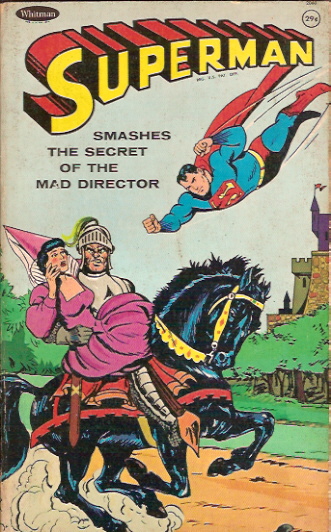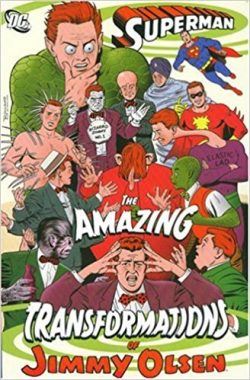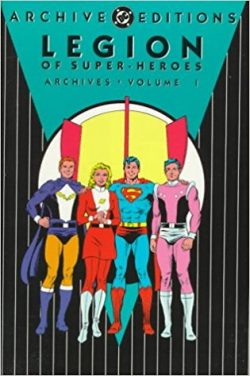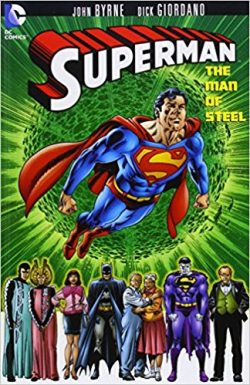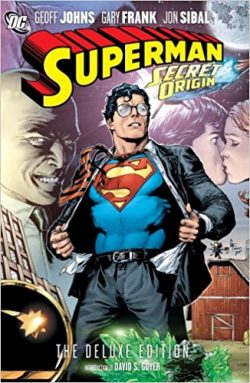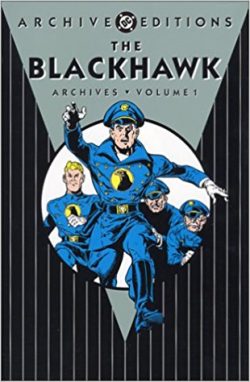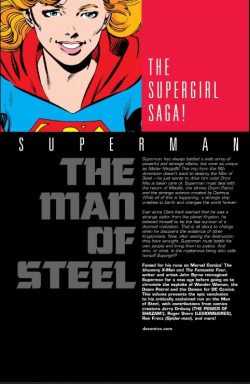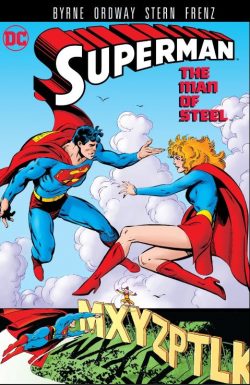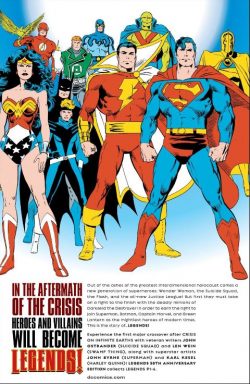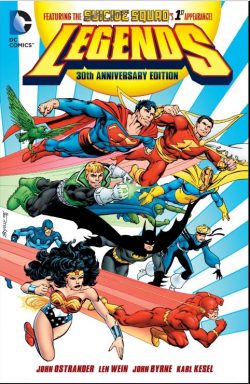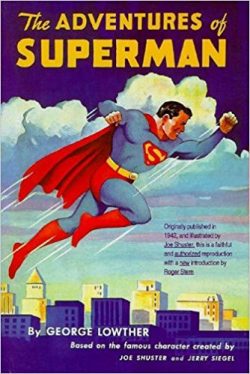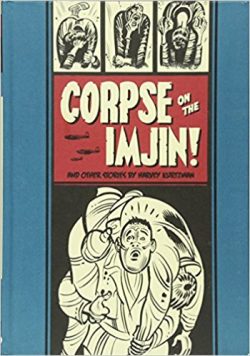
By Harvey Kurtzman with Alex Toth, John Severin, Joe Kubert, Russ Heath, Dave Berg, Ric Estrada, Gene Colan, Johnny Craig others (Fantagraphics Books)
ISBN: 978-1-60699-545-7
The legendary EC Comics began in 1944 when comicbook pioneer Max Gaines sold the superhero properties of his All-American Comics company to half-sister National/DC, retaining only Pictures Stories from the Bible.
His plan was to produce a line of Educational Comics with schools and church groups as the major target market and he augmented his core title with Picture Stories from American History, Picture Stories from Science and Picture Stories from World History. Sadly, the worthy project was already struggling badly when he died in a boating accident in 1947.
As detailed in the final comprehensive essay in this superb graphic collection – available as a sturdily spiffy hardcover or in various eBook formats – his son William was dragged into the family business and, with much support and encouragement from unsung hero Sol Cohen (who held the company together until the initially unwilling Bill Gaines abandoned his dreams of a career in chemistry) transformed the ailing enterprise into Entertaining Comics…
After a few tentative false starts and abortive experiments, Gaines and his multi-talented associate Al Feldstein settled into a bold and impressive publishing strategy, utilising the most gifted illustrators in the field to tell a “New Trend†of stories aimed at an older and more discerning readership.
From 1950-1954 EC was the most innovative and influential publisher in America, dominating the genres of crime, horror, war and science fiction and, under the auspices of writer, artist and editor Harvey Kurtzman, the inventor of an entirely new beast: the satirical comicbook…
Kurtzman was hired to supplement the workforce on the horror titles but wasn’t keen on the genre and instead suggested a new action-adventure title. The result was Two-Fisted Tales which began with issue #18 at the end of 1959 as an anthology of rip-snorting, he-man suspense dramas. However, with America embroiled in a military “police action†in Korea, the title soon became primarily a war comic and was rapidly augmented by another.
Frontline Combat was also written and edited by Kurtzman, who assiduously laid-out and meticulously designed every story. It made for great entertainment and a unifying authorial voice but was frequently a cause of friction with many artists…
In keeping with the New Trend spirit, these war stories were not bombastic, jingoistic fantasies for glory-hungry little boys, but rather subtly subversive examinations of the cost of conflict which highlighted the madness, futility and senseless, pointless waste of it all…
Kurtzman was a cartoon genius and probably the most important cartoonist of the last half of the 20th century. His early triumphs in the fledgling field of comicbooks (especially the groundbreaking Mad magazine) would be enough for most creators to lean back on but Kurtzman was a force in newspaper strips (See Flash Gordon Complete Daily Strips 1951-1953) and restless innovator. As a commentator and social explorer, he just kept on looking at folk and their doings: a man with exacting standards who just couldn’t stop creating.
Kurtzman invented a whole new format and gave America Popular Satire by converting his highly successful full-colour baby Mad into a monochrome magazine, safely distancing the outrageously brilliant comedic publication from the fall-out caused by the 1950s socio-political witch-hunt which eventually killed all EC’s other titles.
He pursued his unique brand of thoughtfully outré comedy and social satire further with the magazines Trump, Humbug and Help!, all the while still conceiving challenging and powerfully effective funny strips such as Little Annie Fannie (for Playboy), The Jungle Book, Nutz, Goodman Beaver, Betsy and her Buddies and many more. He died far too young in 1993.
This first volume of the Fantagraphics EC Library gathers a stunning selection of Kurtzman stories in a lavish monochrome hardcover edition, packed with supplementary interviews, features and dissertations, and opens with ‘The Truth’ by cartoonist and historian R.C. Harvey, describing in stark detail the history of Kurtzman’s EC days.
Then follows a raft of stirring sagas solely from the master’s hand, beginning with ‘Conquest’ from Two-Fisted Tales #18, which with acerbic aplomb relates the rise and fall of Spanish conquistador Juan Alvorado whose rapacious hunger for Aztec gold led inexorably to the downfall and doom of his entire expedition.
‘Jivaro Death’ (#19) deals with modern-day greed as two duplicitous Yankees search for diamonds in the heart of the Amazon jungle whilst T-FT #20 detailed the fate of an amnesiac buccaneer who returned from certain death to obsessively reclaim his ‘Pirate Gold’ from the men who betrayed him…
From issue #21 comes ‘Search!’ which ironically combines an Italian-American’s search for family with the devastating US assault on Anzio in 1943, after which the first selection from Frontline Combat provides an uncharacteristically patriotic clash with the North Korean aggressors in ‘Contact!’ (#2, September 1951).
‘Kill’ from T-FT #23 also takes place in Korea, relating a squalid encounter between a blood-thirsty knife-wielding G.I. psycho and his soulless Commie antithesis, whilst ‘Prisoner of War!’ (FC #3) highlights the numbing, inhuman brutality of combat when American POWs attempt an escape…
‘Rubble!’ (T-FT #24) boldly steps into “enemy†shoes by highlighting the war’s casual cost to simple Korean civilians whilst ‘Air Burst!’ in FC #4 goes even further by voicing the Communist soldiers’ side of the conflict.
The eponymous ‘Corpse on the Imjin!’ (T-FT #25) is one of the most memorable, moving and respected tales of the genre: a genuine anti-war story which elegiacally traces a floating body’s motion down the river to expose the ruminations of the doomed observers who see it.
The sentiment is further explored in ‘Big ‘If’!’ (FC #5) as G.I. Paul Maynard sits in a shell hole and ponders what might have been…
Kurtzman’s unique display of cartooning and craftsmanship is followed by the essay ‘Combat Duty’ wherein Jared Gardner discusses the background and usage of the other artists who worked on the author’s Two-Fisted Tales and Frontline Combat scripts, before ‘Marines Retreat!’ – drawn by John Severin and inked by Kurtzman from FC #1 (July/August 1951) – describes in microcosm the shocking American forced withdrawal from the Changjin Reservoir in December 1950. The event stunned and terrified the folks at home and shook forever the cherished belief in the US Marines’ invincibility, and this is all told through the eyes of a soldier who understands too late the values he was supposed to be fighting for…
Kurtzman’s relationship with his artists could be fraught. Alex Toth, a tempestuous individualist who only drew three tales from his editor’s incredibly detailed lay-outs, famously produced some of his very best work at EC under such creative duress. The first and least was ‘Dying City!’ (T-FT #22) which found an aged Korean grandfather berating his dying descendent for the death and destruction he had brought upon his family and nation,
‘O.P.!’ was drawn by hyper-realist Russ Heath (FC #1) and once more ladled on the bleak, black irony during an annihilating trench encounter during WWI, after which Toth’s astounding aerial imagination produced in ‘Thunderjet!’ (FC #8) one of the most thrilling and evocative dogfight dramas in comics history.
This tale alone is worth the price of admission and was an alarm-call to complacent America as a US pilot is forced to concede that his winged weapon is technologically inferior to the ever-present Communist MIGs…
‘Fire Mission!’ (T-FT #29) was drawn by Dave Berg – an artist far better regarded for his comedy work – who lent his facility with expressions to a rather standard tale of courage discovered under fire in Korea, after which Gene Colan delineated the rift between military and civilians in the hours before the attack on Pearl Harbor in ‘Wake!’ from T-FT #30.
From the same issue ‘Bunker!’ was the first strip illustrated by Ric Estrada, describing rivalry and tension between American units during a Korean offensive. Oddly enough for the times, the fact that one faction was comprised of Negro soldiers was not mentioned at all…
The Cuban artist then drew a chillingly macabre tale of Teddy Roosevelt and the Spanish American war of 1898 in ‘Rough Riders!’ (FC #11) before master of comics noir Johnny Craig detailed the fate of a ‘Lost Battalion!’ in WWI (T-FT #32, March/April 1953).
From the same issue, ‘Tide!’ was an EC debut tale for the already-legendary Joe Kubert depicting a D-Day debacle and its insignificance in the grand scheme of things, whilst Toth’s magnificent Kurtzman-scripted swansong ‘F-86 Sabre Jet!’ (FCÂ #12) revisited and even surpassed his Thunderjet job with a potent and beguiling reductionist minimalism that perfectly captured the disorienting hell of war in the air.
Due to illness and the increasing workload caused by Mad, Kurtzman’s involvement with war titles gradually dwindled. Frontline Combat #14, (October 1953) provided his last collaboration with Kubert in ‘Bonhomme Richard!’: a shocking, personalised account of American nautical legend John Paul Jones’ devastating duel with the British warship Serapis – as told by one of the hundreds of ordinary sailors who didn’t survive…
This masterclass in sequential excellence concludes with a salutary tale from the Civil War Special, Two-Fisted Tales #35 (October 1953). Illustrated by Reed Crandall, ‘Memphis!’ blends the destructive horror of the Union’s River Fleet of Ironclads as they inexorably take control of the Mississippi with the irrepressible excitement of Southern kids who simply could not understand what was happening to their parents and families…
Even with the comics extravaganza ended, there’s still more to enjoy as underground cartooning legend Frank Stack discusses the techniques and impact of Kurtzman’s astonishing covers for Two-Fisted Tales and Frontline Combat in ‘Respect for Simplicity – the War Covers of Harvey Kurtzman’; superbly supplemented by a full-colour section representing all of them, even the seldom-seen Two-Fisted Annual 1952.
Also adding to the value is ‘A Conversation with Harvey Kurtzman’ by John Benson, E.B. Boatner & Jay Kinney, which transcribes two interviews from 1979 and 1982, as well as a full appreciation of the great man’s career in ‘Harvey Kurtzman’ by S.C. Ringgenberg.
Rounding everything off is ‘Behind the Panels: Creator Biographies’ a comprehensive run-down of all involved by Bill Mason and others, plus a general heads-up on the entire EC phenomenon in ‘The Ups and Downs of EC Comics: A Short History’ by author, editor, critic and comics fan Ted White.
The short, sweet but severely limited output of EC has been reprinted ad infinitum in the decades since the company died. These astounding stories and art have changed not just comics but also infected the larger world through film and television and via the millions of dedicated devotees still addicted to New Trend tales.
However, as far as I can recall nobody has produced collections faithfully focussing on the contributions of individual creators, and even though fuddy-duddies like me know these timeless classics intimately, this simple innovation has somehow added a new dimension to the readers’ enjoyment.
I strongly suggest that whether you are an aged EC Fan-Addict or nervous newbie, this is a book no comics aficionado can afford to miss…
This edition © 2012 Fantagraphics Books, Inc. All comics stories © 2012 William M. Gaines Agent, Inc., reprinted with permission. All other material © 2012 the respective creators and owners.
